I was beginning to research an article about ARG genres when I came across this interesting tidbit. Without telling the client, an architect renovating an Upper East Side apartment included secret panels, puzzles, poems and artworks that – when they discovered it – led its residents on a scavenger hunt around their own home.
A frequent topic at if:book is the fetishization of the codex in its irreducibly physical qualities. This project – complete with its own fictionalized Da Vinci Code-esque book hidden in the walls of the apartment – takes this to new heights, while arguably gesturing at some of the elitism (the costliness and exclusivity of the postbit atom) implicit in this fetishization.
Category Archives: new_york
itp winter 2005 show
New York University’s Interactive Telecommunications Program recently had its Winter 2005 show. As always, the show was packed with numerous projects and visitors. Some of the work touched upon ideas we think about at the institute.

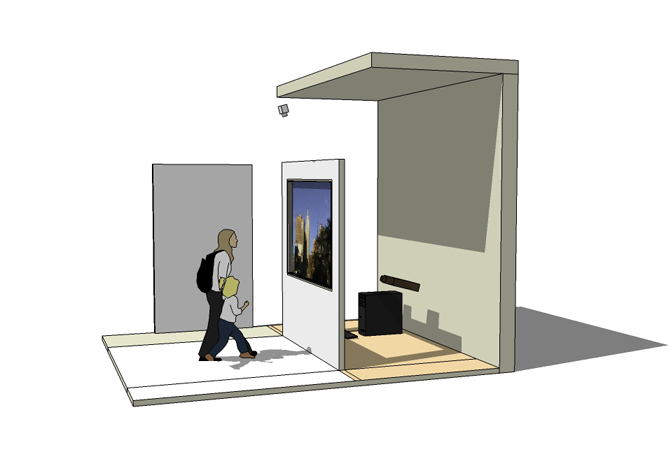
A few projects explored new ways to mediate New York. Leif Mangelsen and Jung Oh, in Time Scanned, created static panoramic images by stitching together slivers of digital video to document New York over time and space. Moving beyond the traditional guide book and map, the augmented reality project, DataCity looked at how we navigate New York. In this case, Shagun Singh, Jon Kirchherr and Saranont Limpananont proposed to layer contextual information on an interactive display system to enhance the experience of traveling through the city.
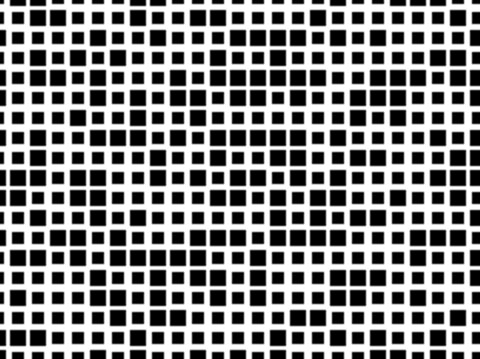 Saiyanthan Sriskandarajah created, The Wasteland, a digital representation of T.S. Eliot’s poem. Each letter is encoded into a binary format and then printed with a large format printer. The end result is an abstracted digital representation of a literary work.
Saiyanthan Sriskandarajah created, The Wasteland, a digital representation of T.S. Eliot’s poem. Each letter is encoded into a binary format and then printed with a large format printer. The end result is an abstracted digital representation of a literary work.
Joshua Knowles, Adam Asarnow, Charles Pratt, and Rocio Barcia created Itp.licio.us which was a new twist to the facebook, and explored folksonomy, privacy, and social networks by asking fellow first year students to tag each other. The successful end result (students received an average of 29.4 tags) also addressed issues of internet mediated social interaction and making public the personal information of what classmates think of others.
Although, the twice a year itp shows can be a bit of an overwhelming experience, they offer a glimpse (albeit scaled down) of emerging applications of technology which are often just around the corner for mainstream use.
hacking nature
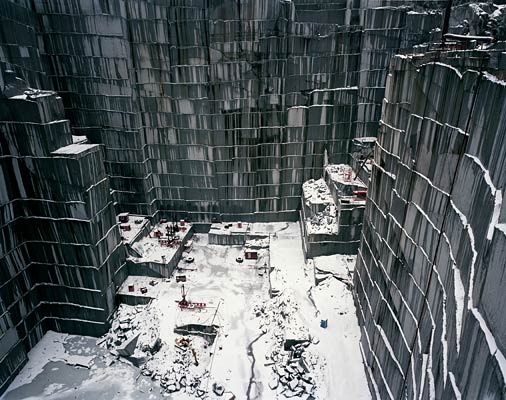
Slate is trying something new with its art criticism: a new “gallery” feature where each month an important artist will be discussed alongside a rich media presentation of their work.
…we’re hoping to emphasize exciting new video and digital art–the kind of art that is hard to reproduce in print magazines.
For their first subject, they don’t push the print envelope terribly far (just a simple slideshow), but they do draw attention to some stunning work by Canadian photographer Edward Burtynsky, who (happily for us New Yorkers) has shows coming this week to the Brooklyn Museum and the Charles Cowles Gallery in Manhattan. Burtynsky documents landscapes bearing the mark of extreme human exploitation – the infernal streams flowing from nickel mines, junked ocean liners rusting in chunks on the beach, abandoned quarries ripe with algae in their cubic trenches, and an arresting series from recent travels through China’s industrial belt.
These photographs carry startling information through the image-surplussed web. But Burtynsky disappoints in one vital, perhaps deciding, respect:
…his position on the moral and political implications of his work is studiously neutral. He doesn’t point fingers or call for change; instead, he accepts industry’s exploitation of the land as the inevitable result of modern progress. “We have extracted from the land from the moment we stood on two feet,” he said in an interview in the exhibition catalog. “The entire 20th century has been a revving up of this large consumptive engine. It’s not a question of whether we are going to stop consuming. It’s not going to happen…”
As someone who believes that struggling to prevent (or at least mitigate) global ecological disaster should be the transcending narrative of our times, I find Burtynsky’s detachment deeply depressing and self-defeating. His images glory in the sick beauty of these ravaged scenes, and the cultural consumers that will no doubt pay large sums for these photographs at his upcoming Chelsea show only compound the cynicism.
light reading
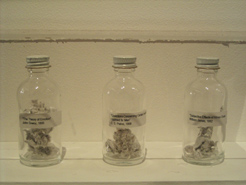 “The Book as Object and Performance exhibition (through January 22 @ Gigantic Art Space in New York, curated by Sara Reisman) presents work by over 20 artists, each using the book as a point of departure to explore the physical, sensual or conceptual dimension of reading and the written word.
“The Book as Object and Performance exhibition (through January 22 @ Gigantic Art Space in New York, curated by Sara Reisman) presents work by over 20 artists, each using the book as a point of departure to explore the physical, sensual or conceptual dimension of reading and the written word.
But despite lofty ambitions, the exhibit provides little more than light reading. Though several works are visually arresting, few do more than glide over the potentially bottomless themes at hand. Most stick to playful reorganization of materials: a pile of wooden hoops culling newspaper headlines from around the globe; a precarious tower of books with a gaping acid-chewed hole at the top; a doorway filled with crumpled sheets of paper; a dictionary with words dislocated from their definitions. A collection of small, easily forgotten pleasures.
An exception to this is a mysterious piece titled “Perseverance” by Jenny Perlin consisting of a small, worn book in a glass case, above which plays a strange film of man battling anxiety, chewing his nails to the quick. Also memorable was a one-night-only “reading” of the ten commandments by Polish-born artist Maciej Toporowicz, a piece first performed in communist Poland in 1980, and part of small program of live explorations last night, filling out the “performance” part of the equation. The gallery lights are extinguished and Toporowicz takes his place in front of an illuminated glass bowl of water, perched atop an open Bible. He places his face in the water, as though reading through the aqueous medium, and remains there long enough for the audience to start imagining.. what? That he is drowning in this sacred, much-abused text? That he is drawing impossible sustenance from its power? He begins to twitch and tremble. Finally his head rips up out of the water, gasping.
The photo above shows bottles containing philosophical texts that have been literally chewed up and spit out. Click below to see more pictures from the exhibition…
the book as object and performance – exhibit in New york
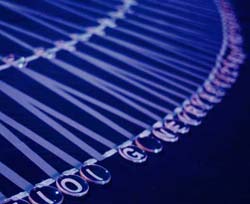
“The Book as Object and Performance is an exhibition of artworks that takes the format of the book as a point of departure to deconstruct that which is bound up in text, image and the physicality of books.”
Through January 22 @ Gigantic Art Space
*Plus: tomorrow night, in conjunction with the exhibition!
Thursday, December 16, 6-8pm: an evening of performances by AUX (Reynard Loki and Christopher Shores), Joseph A. Fish, Jesal Kapadia, Pia Lindman, and Maciej Toporowicz..
NYPL ebook collection leaves much to be desired
I just checked out two titles from the New York Public Library’s ebook catalog, only to learn, to my great astonishment, that those books are now effectively “checked out,” and cannot be downloaded again by anyone else until my copies time out.
It boggles the mind that NYPL would go to the trouble of establishing a collection of electronic titles, only to wipe out every advantage offered by digital texts. In fact, they do more than simply keep the ebooks on the level of print, they limit them further than that, since there are generally multiple copies of most print titles in the NYPL system.
The people responsible for this catalog have either entirely failed to grasp the concept of infinitely accessible, screen-based books, or they grasp it all too well and are trying to stunt it at its inception, perhaps out of fear of extinction of the print librarian. More likely, they are under heavy pressure by a paranoid copyright regime. Whatever the reason, the new ebook catalog shows a total lack of imagination and offers nearly no tangible benefit for the reader.
Beyond that, the books themselves are poorly designed and unpleasant to read. My downloaded copy of Conrad’s Heart of Darkness (which, by the way, I found in the “Romance” section) evidences no more than ten minutes worth of design work, and appears to be simply a cut-and-pasted ASCII file from Gutenberg with a garish graphic slapped on the cover. My copy of Chain of Command by Seymour Hersh was a bit more respectable – more or less a pdf facsimile of the print edition.
On an amusing note, the “literary criticism” section is populated almost entirely by Cliff’s Notes.
3,000 electronic titles at new york public library
This is the third Times article this week on e-books. What’s happening?
“Libraries Reach Out, Online”
No Need to Click Here – we’re just claiming our feed at Feedster
